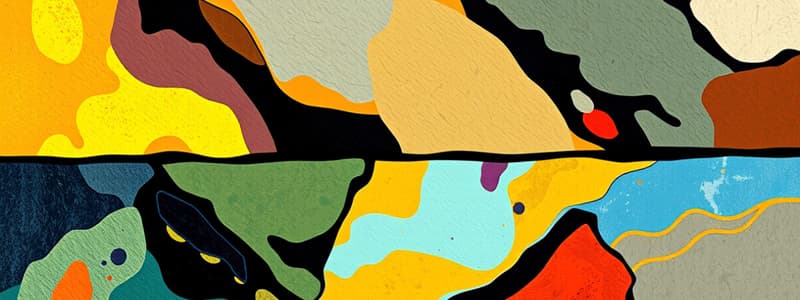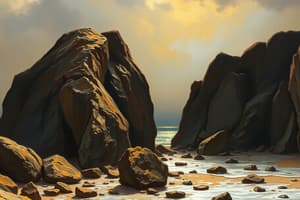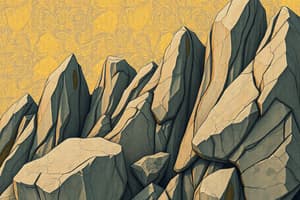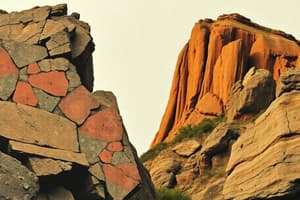Podcast
Questions and Answers
In the simple rock-cycle diagram, which process along path C would change the schist (stage C) directly into a pile?
In the simple rock-cycle diagram, which process along path C would change the schist (stage C) directly into a pile?
uplift, weathering, and erosion of schist
Which rock process is necessary for the formation of igneous?
Which rock process is necessary for the formation of igneous?
solidification
Rocks can be classified as sedimentary, igneous, or metamorphic based primarily upon differences in their?
Rocks can be classified as sedimentary, igneous, or metamorphic based primarily upon differences in their?
origin
Rocks are classified as igneous, sedimentary, or metamorphic based primarily on their?
Rocks are classified as igneous, sedimentary, or metamorphic based primarily on their?
Which process could lead directly to the formation of pumice rock?
Which process could lead directly to the formation of pumice rock?
Most of the rocks shown in the drawings of six sedimentary rocks labeled A through F were formed by?
Most of the rocks shown in the drawings of six sedimentary rocks labeled A through F were formed by?
In which set are the rock drawings labeled with their correct rock types?
In which set are the rock drawings labeled with their correct rock types?
Which process produced rock layer B in the block diagram showing sedimentary layers?
Which process produced rock layer B in the block diagram showing sedimentary layers?
Which table correctly classifies each rock type from the geological processes diagram?
Which table correctly classifies each rock type from the geological processes diagram?
Which relative concentration of elements is found in a mafic rock?
Which relative concentration of elements is found in a mafic rock?
Which statement best describes the formation of an intrusive igneous rock?
Which statement best describes the formation of an intrusive igneous rock?
Which process would form the type of rock that is represented by circle B in the classification diagram?
Which process would form the type of rock that is represented by circle B in the classification diagram?
If the rock in circle C formed from limestone, it would be called?
If the rock in circle C formed from limestone, it would be called?
The classification of rocks into the sedimentary or non-sedimentary groups is based primarily on the rocks'?
The classification of rocks into the sedimentary or non-sedimentary groups is based primarily on the rocks'?
Which rocks could be represented by circles X, Y, and Z in the diagram?
Which rocks could be represented by circles X, Y, and Z in the diagram?
Which extrusive igneous rock is composed of approximately 40% quartz, 20% potassium feldspar, 20% plagioclase feldspar, 10% biotite mica, and 10% hornblende?
Which extrusive igneous rock is composed of approximately 40% quartz, 20% potassium feldspar, 20% plagioclase feldspar, 10% biotite mica, and 10% hornblende?
Which crystal most likely formed from molten material that cooled and solidified most rapidly?
Which crystal most likely formed from molten material that cooled and solidified most rapidly?
Which two rocks have the most similar mineral composition?
Which two rocks have the most similar mineral composition?
Which graph best represents the textures of granite, pegmatite, and rhyolite?
Which graph best represents the textures of granite, pegmatite, and rhyolite?
At which location is metamorphic rock most likely to be found in the geologic cross section?
At which location is metamorphic rock most likely to be found in the geologic cross section?
This rock would be classified as metamorphic because it shows?
This rock would be classified as metamorphic because it shows?
Which rock sample is most likely a foliated metamorphic rock?
Which rock sample is most likely a foliated metamorphic rock?
How do the metamorphic rocks schist and quartzite differ?
How do the metamorphic rocks schist and quartzite differ?
The rock was probably formed by?
The rock was probably formed by?
Which rock is foliated, shows mineral alignment but not banding, and contains medium sized grains of quartz and pyroxene?
Which rock is foliated, shows mineral alignment but not banding, and contains medium sized grains of quartz and pyroxene?
Which rock type is most likely to be monomineralic?
Which rock type is most likely to be monomineralic?
Which sedimentary rocks are clastic and consist of particles that have diameters smaller than 0.006 centimeters?
Which sedimentary rocks are clastic and consist of particles that have diameters smaller than 0.006 centimeters?
Which table shows the rocks correctly classified by texture?
Which table shows the rocks correctly classified by texture?
Which two rocks are composed primarily of quartz, feldspar, and clay minerals?
Which two rocks are composed primarily of quartz, feldspar, and clay minerals?
Which diagram best shows the grain size of some common sedimentary rocks?
Which diagram best shows the grain size of some common sedimentary rocks?
Flashcards
Solidification in Igneous Rocks
Solidification in Igneous Rocks
The process of forming igneous rocks involves the solidification of molten rock (magma or lava).
Rock Classification Criteria
Rock Classification Criteria
The primary method of classifying rocks: sedimentary, igneous, and metamorphic, is based on their origin and how they were formed.
Pumice Formation
Pumice Formation
Volcanic eruptions that release significant amounts of gas and rock fragments can form pumice, a lightweight and porous rock.
Sedimentary Rock Formation
Sedimentary Rock Formation
Signup and view all the flashcards
Rock Layer B Formation
Rock Layer B Formation
Signup and view all the flashcards
Major Rock Types
Major Rock Types
Signup and view all the flashcards
Mafic Rock Composition
Mafic Rock Composition
Signup and view all the flashcards
Intrusive Igneous Rock Texture
Intrusive Igneous Rock Texture
Signup and view all the flashcards
Melting and Solidification in Rocks
Melting and Solidification in Rocks
Signup and view all the flashcards
Limestone to Marble Transformation
Limestone to Marble Transformation
Signup and view all the flashcards
Rock Classification Based on Origin
Rock Classification Based on Origin
Signup and view all the flashcards
Foliation in Metamorphic Rocks
Foliation in Metamorphic Rocks
Signup and view all the flashcards
Distorted Banding in Metamorphic Rocks
Distorted Banding in Metamorphic Rocks
Signup and view all the flashcards
Deformed Structures in Rocks
Deformed Structures in Rocks
Signup and view all the flashcards
Granite and Phyllite Composition
Granite and Phyllite Composition
Signup and view all the flashcards
Rhyolite Composition
Rhyolite Composition
Signup and view all the flashcards
Sample A Classification
Sample A Classification
Signup and view all the flashcards
Rock Salt as Monomineralic
Rock Salt as Monomineralic
Signup and view all the flashcards
Siltstone and Shale as Clastic
Siltstone and Shale as Clastic
Signup and view all the flashcards
Sedimentary Rock Texture Classification
Sedimentary Rock Texture Classification
Signup and view all the flashcards
Sandstone and Shale Composition
Sandstone and Shale Composition
Signup and view all the flashcards
Grain Size Hierarchy in Sedimentary Rocks
Grain Size Hierarchy in Sedimentary Rocks
Signup and view all the flashcards
Schist to Sediment Transformation
Schist to Sediment Transformation
Signup and view all the flashcards
Compaction and Cementation in Sedimentary Rocks
Compaction and Cementation in Sedimentary Rocks
Signup and view all the flashcards
Rock Classification by Origin
Rock Classification by Origin
Signup and view all the flashcards
Igneous Rock Formation
Igneous Rock Formation
Signup and view all the flashcards
Metamorphic Rock Formation
Metamorphic Rock Formation
Signup and view all the flashcards
The Rock Cycle
The Rock Cycle
Signup and view all the flashcards
Study Notes
Rock Cycle and Processes
- Uplift, weathering, and erosion directly change schist into sediments.
- Solidification is essential for igneous rock formation.
- The rock types—sedimentary, igneous, metamorphic—are classified primarily by origin and methods of formation.
- Explosive volcanic eruptions can form pumice rock.
Sedimentary Rocks
- Most sedimentary rocks are formed through compaction and cementation.
- Rock layer B is produced through compaction and cementation processes.
- Tables indicating rock types classify them as sedimentary, igneous, or metamorphic.
Rock Characteristics
- Mafic rocks have high iron and low aluminum concentrations.
- Intrusive igneous rocks are identified by magma that solidifies slowly, leading to coarse-grained textures.
- Melting and solidification processes contribute to certain rock types, such as those represented by circle B in classification diagrams.
Metamorphic Rocks
- If limestone transforms, it becomes marble.
- Classification into sedimentary or non-sedimentary groups is based on origin.
- Foliated metamorphic rocks show mineral alignment and bands, while quartzite lacks foliation.
- Distorted banding signifies a rock's metamorphic classification.
- Rocks may exhibit deformed structure due to heat and pressure acting on them.
Rock Types and Composition
- Granite and phyllite have similar mineral compositions.
- Rhyolite is characterized by specified proportions of minerals such as quartz and feldspar.
- Sample A shows distinctive bands, indicating it is a foliated metamorphic rock.
- Rock salt is an example of a monomineralic rock.
Clastic Sedimentary Rocks
- Siltstone and shale are clastic sedimentary rocks consisting of particles smaller than 0.006 cm.
- Classification based on texture categorizes rocks into clastic, bioclastic, and crystalline.
- Sandstone and shale are primarily made up of quartz, feldspar, and clay minerals.
Grain Size in Sedimentary Rocks
- The grain size hierarchy among common sedimentary rocks places shale as the smallest, siltstone in the middle, and sandstone as the largest.
Studying That Suits You
Use AI to generate personalized quizzes and flashcards to suit your learning preferences.




